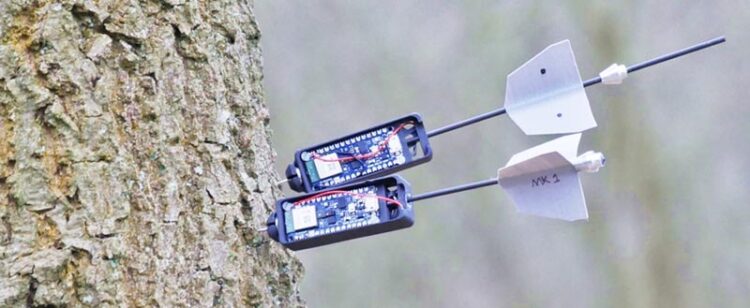Forest dwelling drones – Drones to monitor ecological changes

The flying robots can place arrows equipped with sensors even in dense forests. Image: Imperial College London
A team of researchers from Empa and Imperial College London developed drones that can attach sensors to trees to monitor environmental and ecological changes in forests.
Sensors for forest monitoring are already used to track changes in temperature, humidity and light, as well as the movements of animals and insects through their habitats. They also help to detect and monitor forest fires and can provide valuable data on how climate change and other human activities are affecting the natural world. Placing these sensors can, however, prove difficult in large, tall forests, and climbing trees to place them poses its own risks.
Now, a team of researchers from Empa and Imperial College London has developed drones that can shoot sensor-containing darts onto trees several meters away in cluttered environments like forests. The drones can also place sensors through contact or by perching on tree branches. The researchers hope the drones will be used in future to create networks of sensors to boost data on forest ecosystems and to track hard-to-navigate biomes like the Amazon rainforest.
“Monitoring forest ecosystems can be difficult, but our drones could deploy whole networks of sensors to boost the amount and precision of environmental and ecological data”, says lead researcher Mirko Kovac, head of the Materials and Technology Center of Robotics at Empa and the Aerial Robotics Lab at Imperial. “I like to think of them as artificial forest inhabitants who will soon watch over the ecosystem and provide the data we need to protect these ecosystems.”
The drones are equipped with cameras to help identify suitable targets, and a smart material that changes shape when heated to launch the darts, which then stick to the trees. They can also perch on tree branches like birds to collect data themselves, acting as mobile sensors. The researchers have tested their drones at NEST experimental robot testing space at Empa and on trees at Imperial’s Silwood Park Campus.
The drones are currently controlled by people: Using control units, the researchers watch through the camera lens to select target trees and shoot the darts. The next step is to make the drones autonomous, so that researchers can test how they fare in denser forest environments without human guidance. There are plenty of challenges to be addressed before the drones can be regularly used in forests, like achieving a careful balance between human input and automated tasks so that they can be used safely while remaining adaptable to unpredictable environments.
The research was funded by the Engineering and Physical Sciences Research Council (EPSRC), Offshore Robotics for Certification of Assets Hub (ORCA) EU’s Horizon 2020 and United Kingdom’s national academy of sciences The Royal Society.
Media Contact
All latest news from the category: Ecology, The Environment and Conservation
This complex theme deals primarily with interactions between organisms and the environmental factors that impact them, but to a greater extent between individual inanimate environmental factors.
innovations-report offers informative reports and articles on topics such as climate protection, landscape conservation, ecological systems, wildlife and nature parks and ecosystem efficiency and balance.
Newest articles

NASA: Mystery of life’s handedness deepens
The mystery of why life uses molecules with specific orientations has deepened with a NASA-funded discovery that RNA — a key molecule thought to have potentially held the instructions for…

What are the effects of historic lithium mining on water quality?
Study reveals low levels of common contaminants but high levels of other elements in waters associated with an abandoned lithium mine. Lithium ore and mining waste from a historic lithium…

Quantum-inspired design boosts efficiency of heat-to-electricity conversion
Rice engineers take unconventional route to improving thermophotovoltaic systems. Researchers at Rice University have found a new way to improve a key element of thermophotovoltaic (TPV) systems, which convert heat…



